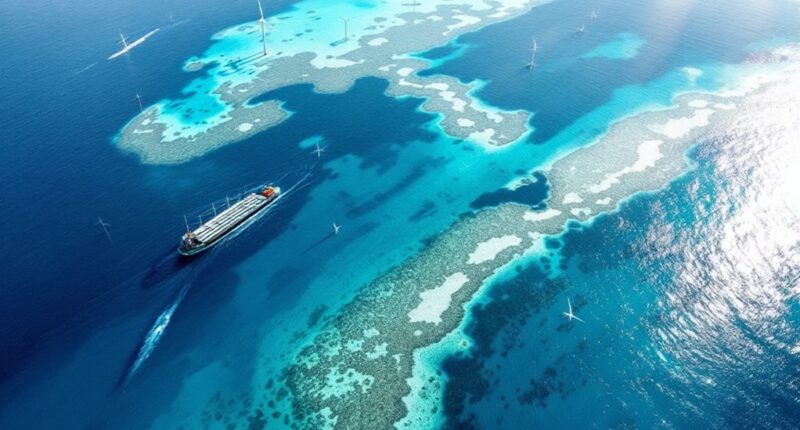The Blue Economy, valued at $1.5 trillion and projected to double by 2030, represents a sustainable approach to ocean resource management. It encompasses diverse sectors including aquaculture, offshore energy, and marine biotechnology while addressing challenges like plastic pollution and overfishing. This model balances economic harvesting with environmental protection, creating opportunities while respecting the rights of traditional fishing communities. The future of our oceans hinges on this delicate balance between prosperity and preservation.

Billions of gallons of possibility stretch across our planet’s blue horizons, where the emerging concept of the “Blue Economy” is transforming how humanity interacts with our oceans. This isn’t just another buzzy economic model—it’s a balancing act between harvesting oceanic wealth and ensuring those same waters continue producing treasures for generations to come.
The Blue Economy is making quite the splash in global markets, currently valued at a cool $1.5 trillion and expected to double to $3 trillion by 2030. Multiple stakeholders define this concept differently, with the finance sector primarily focusing on ocean decarbonization initiatives. Think of it as the ultimate recycling program—extracting value while replenishing resources. The ocean already handles 80% of global trade (those container ships don’t float on optimism) and employs millions worldwide, from fisherfolk to wind farm engineers.
From a $1.5 trillion giant to tomorrow’s $3 trillion powerhouse, the Blue Economy isn’t just making waves—it’s creating tides of opportunity.
Marine sectors are evolving faster than a squid changing colors. Aquaculture—essentially underwater farming minus the tractors—now provides 58% of fish to global markets. Meanwhile, offshore wind farms are sprouting up like dandelions after a spring rain, except these “weeds” power entire cities.
Scientists in lab coats are diving deep into marine biotechnology, hunting for the next medical breakthrough hiding in obscure sea creatures. That strange-looking sponge might contain your future antibiotic—nature’s pharmacy has always been well-stocked beneath the waves.
Of course, challenges loom larger than a whale’s appetite. Plastic pollution, overfishing, and climate change are the party crashers at this oceanic celebration. The concept of Blue Justice acknowledges the historical rights of small-scale fishing communities often overlooked in blue economy initiatives. Sustainable fishing practices using gear restrictions help maintain healthy fish populations while still meeting human consumption needs. The Blue Economy aims to show these uninvited guests the door through improved governance and smarter policies aligned with UN Sustainable Development Goal 14—the ocean’s personal cheerleader.
Success requires international teamwork that would make Olympic synchronized swimmers jealous. Countries must coordinate spatial planning (reserving ocean “neighborhoods” for specific activities) while phasing out harmful subsidies that encourage unsustainable practices.
As innovation surges forward like a dolphin riding a wave, circular economy principles are being applied to maritime industries, proving that what’s good for the planet can also be good for profits. Our blue planet’s future may well depend on getting this delicate dance with the oceans just right.
Frequently Asked Questions
How Does the Blue Economy Differ From Traditional Maritime Industries?
The blue economy transcends traditional maritime industries by integrating sustainability principles with economic growth.
While conventional maritime sectors often focus solely on resource extraction and economic gains, the blue economy balances environmental protection with development.
It incorporates emerging technologies like AI analytics and IoT monitoring, expands to include newer sectors such as marine biotechnology and renewable ocean energy, and prioritizes inclusive growth, social equity, and long-term ecological considerations for coastal communities.
What Technologies Are Emerging to Support Sustainable Ocean Resource Use?
Emerging ocean technologies are transforming sustainable resource management through interconnected innovations.
Remote sensing satellites track sea temperatures and illegal fishing, while AUVs collect essential water quality data underwater. AI systems analyze these massive datasets, identifying patterns human observers might miss.
Meanwhile, engineers are perfecting ways to harness ocean energy through wave, tidal, and current technologies.
These digital and renewable energy advancements represent a fundamental shift toward ocean stewardship that balances economic benefits with ecological preservation.
Which Countries Are Leading Blue Economy Innovation Globally?
Singapore currently leads the blue economy innovation race, with Norway taking a surprising second place ahead of even Silicon Valley’s ecosystem.
The United States remains a powerhouse with eight of the top 25 global blue economy hubs.
China has seen remarkable investment growth in 2024, while Portugal is emerging as a passionate champion on the international stage.
These nations are pioneering sustainable approaches to harnessing ocean resources while balancing economic growth with environmental protection.
How Can Small Coastal Communities Benefit From Blue Economy Initiatives?
Small coastal communities can thrive through blue economy initiatives by embracing sustainable fisheries that provide 90% of coastal employment, developing ecotourism that preserves natural assets while creating jobs, and harnessing renewable ocean energy for local power needs.
Community-led approaches guarantee locals maintain decision-making power, while participatory policies allow flexible engagement levels.
The Blue Justice movement places communities at the development’s center, helping establish community banks that promote financial inclusion across 23 countries.
What Investment Opportunities Exist in Sustainable Ocean Resource Development?
Investors can immerse themselves in several promising blue ventures: offshore wind farms offering 40x growth potential by 2040, wave/tidal energy projects with 350 GW global capacity by 2050, and sustainable aquaculture projected to reach $300B by 2030.
Other opportunities include blue bonds for conservation projects, mangrove restoration yielding 3:1 return ratios, and ocean technology startups riding the wave to a projected $3T blue economy by 2030.









